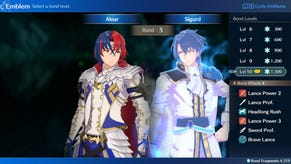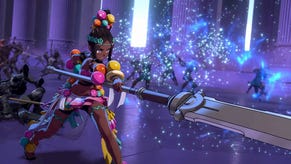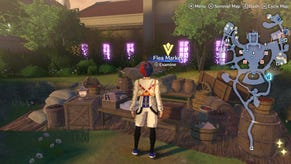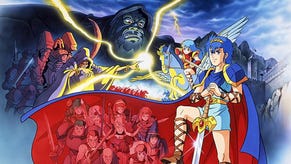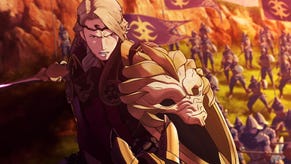Fire Emblem After 15 Years: Remembering the Beloved GBA Game That Brought Fire Emblem to America
We look back on Fire Emblem's first successful foray into North America, and why it remains a popular entry on both sides of the Pacific.
This article first appeared on USgamer, a partner publication of VG247. Some content, such as this article, has been migrated to VG247 for posterity after USgamer's closure - but it has not been edited or further vetted by the VG247 team.
I find myself playing a lot of Fire Emblem Heroes these days. It's a guilty pleasure, but also a chance to revisit some of my favorite characters from over the years, like Lyndis. Unsurprisingly, many of these characters hail from Fire Emblem for GBA, or Blazing Blade as its known to hardcore fans. At last count, Lyndis alone had no fewer than five variants, including a bridal version.
Now celebrating the 15th anniversary of its release in North America, Blazing Blade remains a series touchstone. It gave Fire Emblem a foothold in North America, becoming one of the standards against which all subsequent games in the series were compared. When Fire Emblem Warriors came out last year, Lyndis received a full-blown showcase trailer. Look through Youtube, and one of the videos features promo art reading in big block letters, "MY GIRL."

It's no less popular in Japan. In one online poll, Blazing Blade was listed as the second most popular game in the series, trailing only the Super Famicom's Genealogy of the Holy War. This despite being up against some formidable competition, including the much-loved Mystery of the Emblem and Thracia 776.
Its popularity in the West is mostly owed to the fact that, for many fans including myself, it was the first. Its story isn't as memorable as Genealogy of the Holy War, and it's not as challenging as Thracia 776, but it strikes a balance between difficulty and accessibility that later entries have occasionally struggled to maintain. And while it doesn't excel in any one category, it does have a little something for everyone.
Fire Emblem Comes to America
Known simply as "Fire Emblem" in North America, Blazing Blade was first released on GBA in 2003. It was technically the seventh game in the series, Fire Emblem having gotten its start on the Famicom way back in 1990, but its hardcore tactical RPG gameplay and anime styling resulted in it being passed over for localization in North America. It remained virtually unknown in the West until Super Smash Bros. Melee added Roy and Marth in 2001, thus introducing a generation of English-speaking gamers to Fire Emblem.
Roy and Marth's popularity in Smash Bros. was the green light for Nintendo to finally go ahead with a localized release for Fire Emblem on GBA. In an odd turn though, Nintendo opted to pass over 2002's Binding Blade, which featured Roy, in favor of Blazing Blade—its newer prequel. Roy would make a brief cameo at the end, but Marth wouldn't appear until 2010's Nintendo DS remake of Fire Emblem: Shadow Dragon and the Blade of Light. Binding Blade, sadly, would never receive an English release outside of a later fan translation.
The story of Blazing Blade focused on Lyn, Eliwood, and Hector—three heroes battling against the evil Black Fang with an army of knights, thieves, and mages. All three heroes would end up falling into the heroic nobility archetype common to Fire Emblem, so they weren't especially deep or interesting. But the trio nevertheless had an easy chemistry, made all the more appealing by the fact that they would occasionally turn to the camera and address the player directly, a narrative flourish intended to make them feel like they were along for the journey. In my case, it worked.
With some 40 characters to recruit, many of whom had to be unlocked by fulfilling special conditions, Fire Emblem's massive character pool was another large part of its charm. Whether it was Serra the Sassy Mage or Florina the Pegasus Knight, you could usually find at least a few favorites. You could even pair them up through the Support System, changing their stats and potentially unlocking special endings. In later years, the Support System would become what you might call Fire Emblem's secret ingredient, ultimately serving as the main driver of success for Fire Emblem: Awakening, which was widely credited for reviving the series on the 3DS. More recently, Intelligent Systems has taken it perhaps a bit too far, even going so far as to introduce cringe-worthy petting minigames. But in Blazing Blade, the Support System was a novel addition.
Piggybacking on the success of Super Smash Bros., Fire Emblem was able to find a cult following in North America, myself among them. I discovered Fire Emblem in the cool and rainy summer of 2004, ultimately picking it up on the strength of Advance Wars, which I had loved. It seemed to me that Fire Emblem was a kind of fantasy Advance Wars, but with more advanced storytelling and deeper RPG mechanics. I was quickly hooked.
Like Advance Wars, the action took place on a top-down map with enemy phases and player phases. It had some superficial similarities to Final Fantasy Tactics, but it ultimately played very differently. Maps were more elaborate, and character customization took a backseat to actual tactics. Instead of killing everyone on the map, most stages were built around defeating a boss and taking control of their fortress. Labyrinthine corridors, treasure chests, and recruitable characters gave it a unique dungeon crawling component.
Central to Fire Emblem's tactics was its famous Weapon Triangle, which forced you to pay careful attention to character positioning. Sword would beat axe, lance would beat sword, and axe would beat lance, meaning you had to take care lest your squishy glass cannon was annihilated by a lance-wielding armored unit. Additional wrinkles included magic, which had its own triangle, and bows, which could one-shot flying characters (and often did).
If you did screw up and lose a character, you usually had to reset, as that party member was gone for good. Fire Emblem's permadeath mechanic was famously punishing, precluding saving and reloading by autosaving at the moment of death. Your only option was to go back to the beginning of the level and try again. More than a few would-be fans bounced off the series permanently after one too many resets.
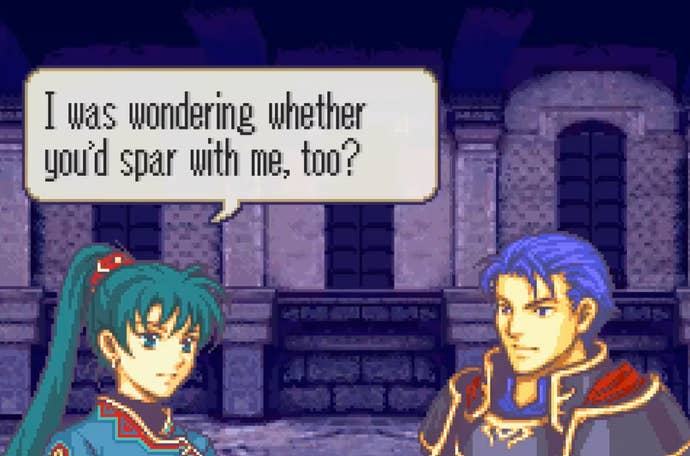
Permadeath mattered not just because it raised the stakes, but because Fire Emblem had a large and vibrant cast of bespoke characters to choose from. It wasn't like XCOM, which was comprised entirely of randomly-generated characters, or even Final Fantasy Tactics, which had a mixture of the two. Characters like Jaffar had their own arcs and potential love interests, which could be snuffed out in a moment of carelessness.
I certainly had my share of frustrating moments, more than once losing a character on the final turn. Rarely did I make it all the way through a run without losing at least one character for good. But in a weird way, it further endeared me to Fire Emblem, as it made me care about my party members irrespective of their cliched fantasy characterizations. When a character made it to the end, it meant something.
I wound up beating Fire Emblem multiple times, my appreciation for it growing with each playthrough. I particularly loved the sprite art and its lovely animated flourishes, which looked amazing on the little GBA screen. You would see Hector toss his axe in the air before a heavy strike, or the swish of Eliwood's cape as he swept in with his sword. It was with a tinge of sadness that I watched the series abandon this gorgeous spritework for rougher, less interesting 3D models in later games. Even now, I still prefer that look to the modern games.
Fire Emblem's final chapters saw you recruit Athos, who acted as a kind of mix of Gandalf and Street Fighter's Sheng Long. He brought incredibly powerful magic to the table, and you needed it, because the final battle pitted you against a dragon so huge that it couldn't even fit on the screen (a series staple, as I later discovered). Watching Athos break out his best spells made me think of Gandalf yelling "You shall not pass!" while fighting the Balrog, which was a neat trick for a 16-bit handheld game.
As the credits rolled, you could see what happened to your party members. Those you paired together usually ended up getting married. Those you let perish received only a brief note listing the chapter in which they fell. It left you with the sense that you were leading an actual army of autonomous individuals whose lives changed depending on your actions—another neat trick.
Fire Emblem: Blazing Blade's Legacy
Fire Emblem: Blazing Blade made me a long-term fan, and in the years since, I've watched as Fire Emblem has gone from a niche tactics series to one of Nintendo's most popular franchises. I've played a lot of Fire Emblem in that time, but Blazing Blade remains first in my heart. It had several of my favorite characters from the series, it had the best art design, and it was loaded with postgame content.
It also did a better job than most in balancing the tension between Fire Emblem's two main tentpoles—romance and tactics. It had romance without going full lolicon. It gave you a lot of powerful characters at the outset, but its hardest levels could still test you. It put a fair amount of emphasis on supports, but also on permadeath, which couldn't yet be turned off. And if you needed an even greater challenge, you could always play through Hector's story, which unlocked after the credits rolled.
In the tradition of Blizzard and other successful mainstream strategy game developers, Fire Emblem: Blazing Sword walked the thin line between depth and accessibility, putting even its most hardcore elements in the best possible light. In so doing, it showed a generation of fans that there was much more to Intelligent Systems' grand tactics series than Marth and Roy. And in the end, it paved the way for Fire Emblem to join Mario, Zelda, and Metroid as one of Nintendo's most important and beloved franchises.





